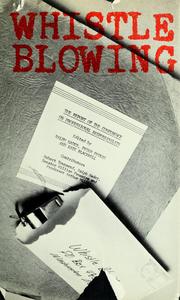

| WHISTLE BLOWING The Report of the Conference on Professional Responsibility Ralph Nader (ed.) Peter J. Petkas (ed.) Kate Blackwell (ed.) New York: Grossman Publishers, September 1972 |
Rating: 5.0 High |
|||
| ISBN-13 978-0-670-76224-8 | ||||
| ISBN 0-670-76224-5 | 302pp. | HC | $? | |
The Conference on Professional Responsibility was held in Washington, DC on 30 January 1971. Organized by Ralph Nader and Peter Petkas, and sponsored by the Clearinghouse for Professional Responsibility, it drew together a number of the leading advocates of speaking out against corporate malpractice and featured several citizens who had done so. Whistle Blowing is the report of that conference.
At that time, whistle blowers — those citizens who reveal misbehavior on the part of corporations or government agencies — enjoyed imperfect legal safeguards against retaliation by the organizations they criticized.1 They were routinely harassed by superiors and shunned by co-workers. It was common for them to be fired, often on trumped-up charges of insubordination or incompetence; or, if this form of retaliation was blocked, their jobs could be eliminated.
"The employee of public government who snitches can often expect to be fired, cast into some obscure limbo, or criminally punished. Those who are not protected by civil service regulations—including political appointees and persons whose services are contracted to the government by corporations and consulting firms—are particularly vulnerable. Unfortunately, this category, since it includes many scientists and others with a reputation for independent initiative, covers those most likely to blow the whistle and to do so effectively. Job security for these whistle blowers is not great, as Walter Hickel learned."2 "If he is wrapped in the security of civil service regulations, he may be less vulnerable, since he cannot be dismissed without cause and without the benefit of minimum procedural rights, in some cases including a full hearing. A full hearing is what those who have the whistle blown on them least want—whether that hearing be a formal, judicial-type hearing or an informal hearing from which may come documents and exhibits subject to public scrutiny. The clever administrator can usually avoid all this by simply abolishing the job [held by] the whistle blower." – Robert Townsend, Page 27 |
The My Lai Massacre took place in March 1968. Six months later a soldier, Tom Glen, wrote to General Creighton Abrams, the new commander in Viet Nam, describing the atrocities. But it was Ron Ridenhour, a former member of Charlie Company, who provided the most detailed reports — details he learned by talking to Charlie Company men who took part. In March 1969 he wrote to President Richard Nixon, the Pentagon, the State Department, the Joint Chiefs of Staff and numerous members of Congress. Senators Barry Goldwater (R-AZ) and Edward Brooke (R-MA), along with Congressman Morris Udall (D-AZ), pressed for an investigation.
Ron Ridenhour did much more than just collect information about My Lai and write some letters alerting the world to the story. After leaving the service, he became an investigative journalist and has a number of important stories to his credit. Also, his example was such that it inspired the creation of the Ridenhour Prizes, now in their seventh year. The winner of the 2011 Truth-teller Prize is Thomas Drake, who surfaced massive waste at the NSA as well as unconstitutional activity by NSA managers. the DOJ indicted Drake in April 2010 for "espionage." His trial begins on 13 June of this year. Lack-of-change we can believe in.
The Conference was in fact faced with an "embarrassment of riches." Not only did it present the nine cases covered in chapters 6 through 14, which had presumably made newspaper headlines at the time, but the less familiar figures covered in Chapter 15 of the book. Still, some of those names will be instantly recognizable — like the name of Frank Serpico.3 Those twenty-one cases involve at least 24 protestors, and the following chapters name still more.
Following these case studies, the prospects for whistle-blowing in corporations, in government, and under then-current laws are examined in detail. The final chapter presents a set of guiding principles for whistleblowers. These are intended to assure they put together a solid, actionable case and first meet with internal authorities (if warranted) before going public. This chapter also contains good advice on when not to blow the whistle.
The book is a well-written testament to the persistence and pervasiveness of the problem, showing clearly how necessary whistle blowing is to the country. The case studies drive the point home. It is an unfortunate trait of H. sapiens that its members' quality of "knowing" can be so easily subverted by greed, personal animosities, or just random distractions. The result, invariably, is that the corners cut by people of authority (in government or in the corporate realm) for the stated goal of saving time or money end up causing the loss of massive amounts of both time and money, along with considerable amounts of the public's faith in the competence of government and corporations — and, too often, the loss of human lives.
There are very few errors in the text. The worst defect is that the 21 cases presented in Chapter 15 are somewhat sketchily described. I found myself wishing for more information, especially since it is hard to research many of these cases on-line.4
Read this book, if you can find it, and keep a copy if you can buy it.

 To contact Chris Winter, send email to this address.
To contact Chris Winter, send email to this address.